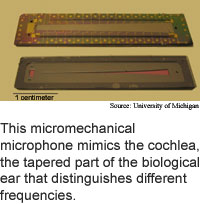
Artificial cochlea tells tones
apart
Researchers from the University of Michigan
have constructed a hydromechanical device that is the size of and emulates
the basic function of the cochlea structure of the mammalian ear. The
cochlea converts sound waves to nerve impulses.
The human cochlea senses sounds that vibrate from 20 to 20,000
cycles per second and can distinguish tones that differ by less than half
a percent, covers a loudness range of 120 decibels, can separate audio
signals into 3,500 channels of frequency information, and is less than
one square centimeter in size.
The artificial cochlea makes it easier to study the precise mechanics
of the ear. It also paves the way for economical microphones that work
as well as ears, and could eventually be used as cochlear prostheses,
according to the researchers.
The researchers constructed the device using micromachining methods
similar to those used to make computer chips, which means it is possible
to produce the cochlear devices in bulk.
Like the biological ear, the device uses a fluid-filled channel
to determine the frequency of a sound. An incoming sound causes a wave
in the fluid. Because the thickness of the membrane covering the channel
varies, a sound of a particular frequency displaces the membrane most
at a specific spot. Adding sensors along the membrane will make it possible
to convert the mechanical changes to electrical signals.
The researchers' device will be ready for practical use as a microphone
that performs real-time frequency analysis in two to five years, and as
a cochlear prosthesis in five to ten years, according to the researchers.
A cochlear prosthesis also requires electronics that read the membrane
signals and active feedback elements that emulate the other complex processes
that occur in ears to increase sound sensitivity, discrimination and range.
The work appeared in the January 21, 2005 issue of the Proceedings
of the National Academy Of Sciences.
Snapshots save digital evidence
Software organizes email by task
Wire guides terahertz waves
How it Works Files:
Pattern Recognition
Briefs:
Quantum crypto scheme goes one-way
Method makes double nanotubes
Material promises denser DVDs
Artificial cochlea tells tones apart
Nanotubes boost molecular devices
Avalanches up disk storage
Silicon chip laser goes continuous

Research Watch blog
View from the High Ground Q&A
How It Works
RSS Feeds:
News
Ad links:
Buy an ad link
Ad links: Clear History
Buy an ad link
|
TRN
Newswire and Headline Feeds for Web sites
|
© Copyright Technology Research News, LLC 2000-2010. All rights reserved.